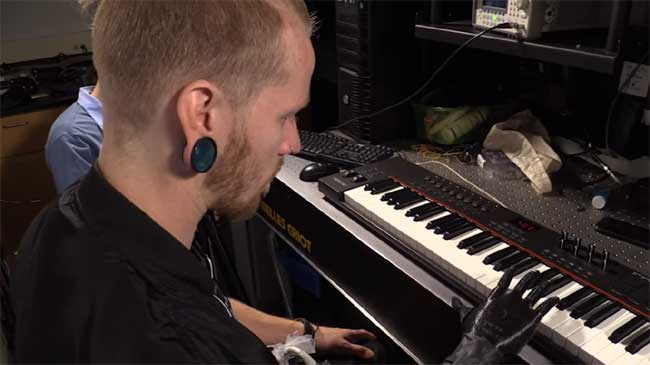
Luke Skywalker’s bionic hand made possible by ultrasound technology
It’s going to be real that a disabled person will able to use Piano or play musical instruments, by an amazing invention by Luke Skywalker’s, he made a bionic hand which is not far from reality for amputees on the Earth. Researchers of the Georgia Institute of Technology made an ultrasonic sensor which allows the amputees to control their prosthetic figure individually, with motor hand gestures which could not be possible to make through current commercially available devices.
Jason Barnes a famous drummer electrocuted his right arm five years ago due to an accident but he forced a doctor to amputate his right arm below the elbow, so he has the muscles that control the finger. He is working with Weinberg and used the bionic hand for the first time and get able to use piano and also played the Star Wars theme song on guitar too with the bionic hand.
“Our prosthetic arm is powered by ultrasound signals, by using this new technology, the arm can detect which fingers an amputee wants to move, even if they don’t have fingers,” said Gil Weinberg, the Georgia Tech College of Design professor who leads the project.
Barnes used available electromyogram (EMG) sensors (attached to his muscles) before it, but the sensors are not that much accurate in comparison to the present one. “EMG sensors aren’t very accurate, they can detect a muscle movement, but the signal is too noisy to infer which finger the person wants to move. We tried to improve the pattern detection from EMG for Jason but couldn’t get finger-by-finger control” said Weinberg, director of Georgia Tech’s Center for Music Technology.
Then the team saw an ultrasonic machine around the lab, and they partnered with two more professors of Georgia Tech - Minoru Shinohara, Chris Fink and Levent Degertekin and with the help of them they got success in attachment an ultrasound probe to the arm. The same probe used by doctors for checking the movement of the babies in the womb and they used it for watching how Barnes’ muscles moved.
“That’s when we had a Eureka moment,” said Weinberg.
Weinberg and his team fed each unique movement of Barnes' muscle into an algorithm that is fastly able to justify which finger wants to move. The bionic hand is also able to detect continuous and simultaneous movements of each finger with the exact calculation of force intended by the disabled person.
“It’s completely mind-blowing, this new arm allows me to do whatever grip I want, on the fly, without changing modes or pressing a button. I never thought we’d be able to do this” said Barnes.
The first invention of Weinberg’s Lab for Barnes is that they fitted him with a prosthetic arm with two drumsticks in 2014. Now the bionic hand is the second creation for Barnes by Weinberg’s Lab. The first creation gave him a chance to play the drum again with a stick that plays faster than any drummer in the world, as he loves to play drum more. Weinberg’s robot is catching attention worldwide for concerts by Barnes across four continents, one of them was performed by Barnes at the Kennedy Center in Washington, D.C., and Moogfest. So, the first creation takes Weinberg to an impressive level of creation so they think for the second creation to amaze the world by Barnes bionic hand and the performance he is lacked since 2012.
“If this type of arm can work on music, something as subtle and expressive as playing the piano, this technology can also be used for many other types of fine motor activities such as bathing, grooming, and feeding, I also envision able-bodied persons being able to remotely control robotic arms and hands by simply moving their fingers” said Weinberg.
Source: Georgia Tech

